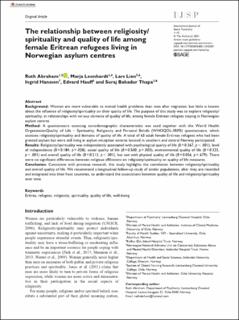| dc.description.abstract | Abstract
Background:
Women are more vulnerable to mental health problems than men after migration, but little is known about the influence of religiosity/spirituality on their quality of life. The purpose of this study was to explore religiosity/spirituality, in relationships with various domains of quality of life, among female Eritrean refugees staying in Norwegian asylum centres.
Method:
A questionnaire assessing sociodemographic characteristics was used together with the World Health OrganizationQuality of Life – Spirituality, Religiosity and Personal Beliefs (WHOQOL-SRPB) questionnaire, which assesses religiosity/spirituality and domains of quality of life. A total of 63 adult female Eritrean refugees who had been granted asylum but were still living in asylum reception centres located in southern and central Norway participated.
Results:
Religiosity/spirituality was independently associated with psychological quality of life (B = 0.367, p < .001), level of independence (B = 0.184, p = .028), social quality of life (B = 0.500, p = .003), environmental quality of life (B = 0.323,p < .001) and overall quality of life (B = 0.213, p < .001), but not with physical quality of life (B = 0.056, p = .679). There were no significant differences between religious affiliations on religiosity/spirituality or quality of life measures.
Conclusion:
Consistent with previous research, this study highlights the correlation between religiosity/spirituality
and overall quality of life. We recommend a longitudinal follow-up study of similar populations, after they are resettled and integrated into their host countries, to understand the associations between quality of life and religiosity/spirituality over time. | en_US |

